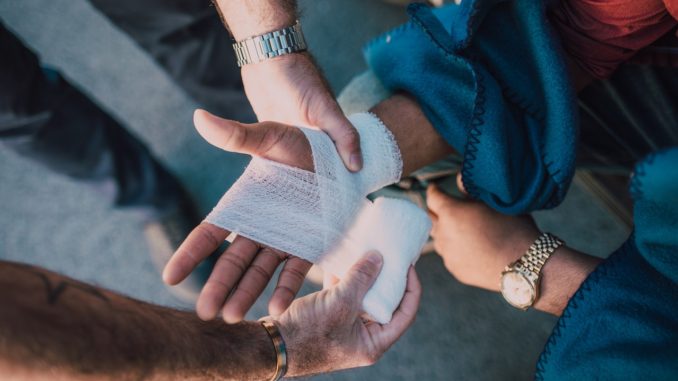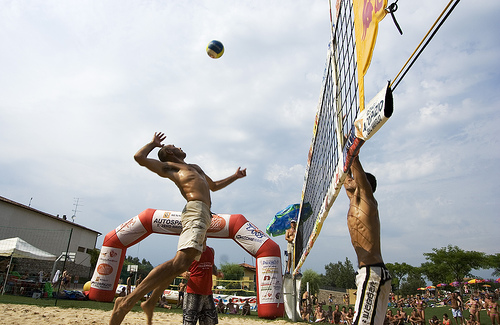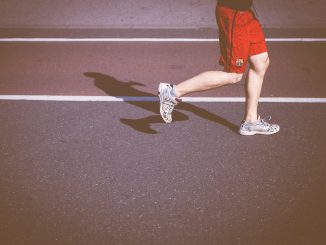
If you’re someone who stays active, you’re bound to face injuries sooner or later. It’s just part of the game. But don’t sweat it. Today, we’ll explore all you need to know about injury recovery. We’ll talk about how to return to your best self when life throws you a curveball.
And guess what? It’s not all doom and gloom! We will cover some tips and tricks to help you stay injury-free. Yep, we’ll chat about how to avoid them in the first place.
So, whether you’re a weekend warrior, a fitness fanatic, or just someone who loves staying active, stick around. We’ll get a deep dive into the world of injury prevention and injury recovery!
Injury – What Is It?

Source: Pexels.com
Injury is simply damage to your body. Whether it’s from the forces from the outside or from the inside of you.
Now, when we talk about external forces, it’s like getting bumped by something or falling down on your nose. Those are the “ouch” moments caused by stuff outside of you.
But your own body can sometimes cause damage too. Think of it as your muscles pulling a little too hard on your body parts in awkward positions – that can also lead to injury.
So, long story short, injuries can come from both the world around you and your own body’s adventures.
Sports injuries can be mild like cuts, sprains, and bruises, or more severe like fractures, joint dislocations, or concussions. Mild injuries will have shorter injury recovery times while more severe injuries will have longer recovery times.
Common Injuries And Injury Recovery Time
1. Ankle Sprains
Common Causes: Twisting or rolling your ankle during physical activities or walking on uneven surfaces.
Recovery Time: Mild sprains may heal in a couple of weeks, while more severe cases can take up to several months. Physical therapy can speed up the process.
2. Strains
Common Causes: Overstretching or tearing of muscles or tendons, typically from sudden movements or overexertion.
Recovery Time: Mild strains might recover in a few weeks with rest, while severe strains may require months of rehabilitation.
3. Rotator Cuff Injuries
Common Causes: Repetitive arm motions, falls, or sudden jerking movements.
Recovery Time: Recovery can range from several weeks to several months, with physical therapy playing a significant role in rehabilitation.
4. Dislocated Joints
Common Causes: Impacts or falls.
Recovery Time: The recovery period depends on the joint affected, but it often involves rest, immobilization, and physical therapy.
5. Torn Ligaments (ACL, MCL)
Common Causes: Often related to sports injuries or sudden twisting movements.
Recovery Time: Recovery can take several months to a year, and surgery is sometimes necessary for complete healing.
6. Fractures (Broken Bones)
Common Causes: Falls, impacts, or accidents.
Recovery Time: The healing time varies greatly depending on the type and location of the fracture. Simple fractures may heal in 6-8 weeks, while complex fractures can take several months.
7. Concussions
Common Causes: Usually caused by a blow to the head, often in contact sports or accidents.
Recovery Time: Recovery can vary greatly, with some people recovering in days or weeks and others needing months or longer. Rest and avoiding re-injury are crucial.
Injury Prevention Is Better Than Injury Recovery
Of course, the best way you can deal with injuries is to avoid injury. Injury will cause pain and suffering, it will keep you away from your favorite activities and lower the joy you can experience in life.
So, if you can prevent it from even happening is the best way to deal with injury.
How To Prevent Injury
If you are leading an active lifestyle, or simply enjoy sports activities, you can reduce the likelihood of injury by following the next few easy steps:
1. Rest between workouts

Source: Pexels.com
Another way to reduce the probability of injury is to rest enough between workout sessions. Anyone who tried building muscle mass knows that muscles grow only when you rest. So, they know the value of resting between workouts.
But it’s not only about muscle growth. If you want to improve your performance between workout sessions, and become stronger and faster you have to rest properly.
If your rest is too short, your body will not recover enough from the last workout. On your next workout, you will not be able to perform as well as on the previous one. Meaning that you will run slower, you will be able to lift less weight or jump shorter distances.
You will become weaker and less capable on each consecutive training session. So, instead of improving, you will be deteriorating. Your muscles, tendons, and joints will become more fragile and prone to injury.
This is why getting enough rest between workouts is so important.
2. Warm up before workout
When I was a young boy, I thought warming up was just a useless waste of time. I skipped it whenever I could. If I was forced to do it I always half-assed it.
Now in my fifties, I don’t even think about starting my workouts without a proper warm-up. When I did skip it, I almost always regretted it the next day or even right after my first set of exercises.
Here’s why warming up is a great idea. When you warm up, you slowly prepare your body for a more active movement that will follow in the main part of the workout or sports activity. It will naturally move your tendons, ligaments, joints, and muscles from a state of inactivity to the increased activity and load that follows.
Your focus will improve and your mind will be better prepared for the workout when you first do a short warm-up session. So, if you are after sports results, your results will improve after the warm-up.
3. Cool down after the workout
After the workout, you can simply stop and continue with your standard life activities. But it will leave your muscles shortened and stiff. You will feel sore the day after because of lactic acid that builds up in your muscles during the workout.
To lengthen your muscles, relax them, and relieve the lactic acid, do a short 5-15-minute cool-down stretching after each workout.
By doing this, your muscles, ligaments, and tendons become more relaxed and flexible. This way you reduce the probability the injury will happen.
4. Use supplements

Source: Pexels.com
During workouts, your joints, ligaments, and tendons are put under increased tension and load. This may lead to damage and pain in your cartilage, meniscus, and other soft tissues.
To reduce this damage, you can use supplements as prevention. The supplements will protect your tissue from damage. Your cartilage will become more flexible and resilient to increased forces.
Even if you get injured, those supplements will help you recover faster after injury. They will reduce pain and help repair smaller damages to your joints.
The supplements will have several active substances that will help with your joint health:
- MSM – will help reduce swelling and pain
- Glucosamine – reduce pain in your joints
- Chondroitin – repairing your cartilage
- Collagen – provides structure and strengthens your muscles, bones, and connective tissue
- Hyaluronic acid – lubricates your joints and provides cushion
5. Use compression clothes or tapes
Another way to prevent injury is by using compression clothes or tapes. The elastic properties of compression clothes and tapes will provide additional stability and support to your joints.
In a way, it will serve as an exoskeleton reducing the load on your joints. This will make your joints, ligaments, and tendons more resilient to injury.
Tips For Fast Injury Recovery
1. Visit A Doctor
The first step after getting injured is getting professional help. Go to the doctor as soon as possible. Doctors will make a quick injury diagnosis and give you pointers on the next steps to take and expected recovery times.
Of course, you won’t go to the doctor for superficial cuts and bruises.
2. Rest
This is the part that I usually mess up. I’m always eager to start working out as fast as possible. It usually only prolongs the time to recovery – sometimes 5 to 10 times longer than necessary.
But resting for too long is bad as well. If you rest too long your muscles will atrophy and your joints will become stiff. So, you will need more time to get back on track.
3. Follow the R.I.C.E Protocol
Rest, Ice, Compression, and Elevation (R.I.C.E) is a standard initial treatment for many injuries. This protocol will help reduce swelling and pain.
4. Do What Doctors Prescribe

Source: Pexels.com
It’s important to listen to the doctor’s instructions and take necessary medication if needed. Medication will reduce pain and inflammation. Physical therapy will reduce the time to recover and restore the physical functions of your body.
5. Use Supportive Aids
Use braces, crutches, or splints if your doctor prescribes it. These supportive aids will help you protect the injured area and prevent the injury from repeating.
6. Slowly Return To Workout
After finishing with physical therapy, slowly start working out. Start with a drastically decreased load when just starting out after the recovery. Take your time. Increase the load slowly.
Listen to your body and avoid pain when working out. Pain will warn you that you are doing too much. Reduce the load.
My Experience With Injuries And Injury Recovery
Unfortunately, I have an extensive experience with injury. My ACL was torn during skiing training when I was 13 years old.
I injured my knees repeatedly and I feel knee pain from time to time reminding me about those injuries.
Both of my shoulders were dislocated many times. I had stabilization surgery on both of my shoulders. Luckily I haven’t experienced dislocation after the surgery.
I’ve been falling, tumbling, getting twisted and turned, and injured in many different ways.
But I’ve always come back after an injury. I may get too eager to return to my training after I get injured and get impatient during my recovery. This has prolonged my recovery more than anything else.
So, if you don’t take anything else from this article, but the importance of staying patient during recovery, you will be well off. This is the number one reason keeping me injured longer than necessary. It’s also something I have to work on the most.
Injury Recovery Conclusion
Being injured and recovering from injury is not a walk in the park. The best is to avoid getting injured in the first place. Use the injury prevention methods described here.
But if you do get injured, there are tried and true ways to follow to get back on track as soon as possible. Injury recovery takes time. So, be patient.
So, please take this article as a reference. Listen to your body and heal fast.




